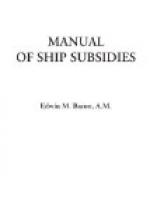Complaints against these new regulations were promptly raised by shipbuilders and ship-outfitters,[BK] and in 1870 a Parliamentary inquiry into their grievances was made. It appeared that shipbuilders, though enabled to import free such materials as they needed, were handicapped by numerous and extensive formalities; while the outfitters were embarrassed by special burdens which the law laid upon them, and which their British competitors did not have to bear.[BL] In 1872 laws were passed which reversed much of the act of 1866. A tax of from thirty to fifty francs a ton measurement was re-imposed on all foreign ships purchased for registration in France, together with a duty on marine engines; again a tonnage duty, of from fifty centimes to one franc, was imposed on ships of any flag coming from a foreign country or from the French colonies; and the provisions freeing materials for ship construction, and admitting foreign-built ships to French registration upon payment of the two-franc tax per ton, were repealed.[BM] In 1873 an extra-parliamentary commission took up the general question of the state of the commercial marine,[BN] and the outcome of this inquiry was the establishment of the system of direct bounties. This system was applied for the first time in the Merchant Marine Act passed in January, 1881.
The act of 1881 granted both construction and navigation premiums, and was limited to ten years. The construction bounties, as was declared, were given “as compensation for the increased cost which the customs tariff imposed on shipbuilders” in consequence of the repeal of the law granting free import of materials by construction; the navigation bounties, “for the purpose of compensating the mercantile navy for the service it renders the country in the recruitment of the military navy.” The construction bounties, on gross tonnage, were as follows: for wooden ships of less than 200 tons, ten francs a ton; of more than 200 tons, twenty francs; for composite ships, that is, ships with iron or steel beams and wooden sides, forty francs a ton; for iron or steel ships, sixty francs; for engines placed on steamers, and for boilers and other auxiliary apparatus, twelve francs per 100 kilograms; for renewing boilers, eight francs per 100 kilograms of new material used; for any modification of a ship increasing its tonnage, the above rates on the net increase of tonnage.[BO] The navigation bounties were confined to ships engaged in the foreign trade, and were to be reduced annually during the ten years’ term of the law.[BP] They were thus fixed: for French-built ships, one franc and fifty centimes a registered ton for every thousand sea miles sailed the first year, the rate to diminish each succeeding year of the term seven francs and fifty centimes on wooden ships, and five centimes on iron and steel ships; for foreign-built ships owned by Frenchmen admitted to registry, one-half the above rates; for French-built steamers constructed according to plans of the Navy Department, an increase of fifteen per cent above the ordinary rate.[BQ]




